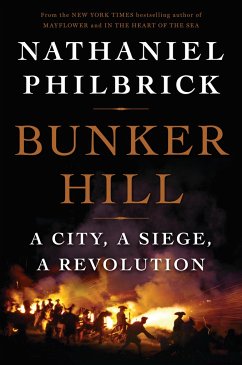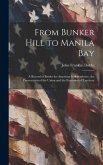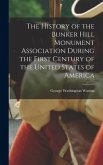Philbrick, the bestselling author of "In the Heart of the Sea" and "Mayflower," brings his prodigious talents to the story of the Boston battle that ignited the American Revolution.
The bestselling author of In the Heart of the Sea, Mayflower, and In the Hurricane's Eye tells the story of the Boston battle that ignited the American Revolution, in this "masterpiece of narrative and perspective." (Boston Globe) In the opening volume of his acclaimed American Revolution series, Nathaniel Philbrick turns his keen eye to pre-Revolutionary Boston and the spark that ignited the American Revolution. In the aftermath of the Boston Tea Party and the violence at Lexington and Concord, the conflict escalated and skirmishes gave way to outright war in the Battle of Bunker Hill. It was the bloodiest conflict of the revolutionary war, and the point of no return for the rebellious colonists. Philbrick gives us a fresh view of the story and its dynamic personalities, including John Adams, Samuel Adams, John Hancock, Paul Revere, and George Washington. With passion and insight, he reconstructs the revolutionary landscape-geographic and ideological-in a mesmerizing narrative of the robust, messy, blisteringly real origins of America.
The bestselling author of In the Heart of the Sea, Mayflower, and In the Hurricane's Eye tells the story of the Boston battle that ignited the American Revolution, in this "masterpiece of narrative and perspective." (Boston Globe) In the opening volume of his acclaimed American Revolution series, Nathaniel Philbrick turns his keen eye to pre-Revolutionary Boston and the spark that ignited the American Revolution. In the aftermath of the Boston Tea Party and the violence at Lexington and Concord, the conflict escalated and skirmishes gave way to outright war in the Battle of Bunker Hill. It was the bloodiest conflict of the revolutionary war, and the point of no return for the rebellious colonists. Philbrick gives us a fresh view of the story and its dynamic personalities, including John Adams, Samuel Adams, John Hancock, Paul Revere, and George Washington. With passion and insight, he reconstructs the revolutionary landscape-geographic and ideological-in a mesmerizing narrative of the robust, messy, blisteringly real origins of America.

Schlacht mit falschem Namen: Nathaniel Philbrick erzählt, wie in Boston die Revolution gegen England begann
Auf dem Boden von Boston verläuft heute ein rotes Band, das die Besucher der Hauptstadt von Massachusetts an die historischen Stätten der Amerikanischen Revolution führt. Früher war Boston, 1630 von puritanischen Kolonisten gegründet, fast eine Insel, vom Festland aus nur über einen schmalen Landstreifen zu erreichen. Als die amerikanischen Kolonien in den sechziger und siebziger Jahren des achtzehnten Jahrhunderts mit dem englischen Mutterland um Steuern und Selbstbestimmung stritten, wurde die geschäftige Hafenstadt zum Schauplatz des politischen wie des handfesten Protests.
Wer dem rotmarkierten "Freedom Trail" folgt, steht schließlich jenseits des Charles River vor einem Turm, der an die Schlacht von Bunker Hill erinnert. Die Schlacht vom 17. Juni 1775, kurz nach Ausbruch des Unabhängigkeitskriegs, trägt den falschen Namen, und sie brachte eine Niederlage für die aufständischen Amerikaner. Warum sie wie ein Sieg wirkte, erzählt Nathaniel Philbrick in diesem beachtlichen Buch über den Beginn der Revolution in Boston. Philbricks historische Sachbücher sind Bestseller in Amerika. Der gebürtige Bostoner lebt auf der Walfanginsel Nantucket; dort lernte er, wie sich Zwist und Neid, Familien- und Freundschaftsbande auf eine Inselgemeinschaft auswirken.
Den protestierenden Kolonisten ging es anfangs nicht um die Unabhängigkeit vom Mutterland, sondern um die Verteidigung von althergebrachten Freiheiten, die sie durch Besteuerung und Truppenstationierung bedroht sahen. Der Protest machte Boston zur gespaltenen Stadt, in der es zwischen Aufständischen und englandtreuen Loyalisten immer weniger Neutrale gab, dafür aber umso mehr britische Soldaten. Philbrick ist ein fesselnder Erzähler, der in Forschungsliteratur und Quellen anschauliche Details aufspürt. So beschreibt er den Widerstand nicht nur als Frage der politischen Willensbildung, sondern auch als psychosomatische Last, denn fast jeden Wortführer der Protestbewegung plagten zeitweise Gesundheitsprobleme bis hin zu Nervenzusammenbruch und Depression.
Am 19. April 1775 kam es in Lexington und Concord zu Gefechten zwischen lokalen Miliztruppen und britischen Soldaten, die ein Waffenlager der Miliz ausheben sollten. Damit begann der Unabhängigkeitskrieg. Boston, Standort mehrerer englischer Regimenter, wurde rasch von Tausenden Milizionären belagert. Im Juni wollten die Amerikaner auf dem Bunker Hill über Charlestown ein einfaches Fort aus Erdwällen errichten, doch die dazu entsandten Offiziere wählten stattdessen den weniger geschützten, näher an Boston gelegenen Breed's Hill. Die Briten griffen mit zweitausendzweihundert Mann an, eroberten das Fort, verloren aber mehr als tausend Soldaten. Der Sieg sei "zu teuer erkauft" gewesen, schrieb ihr General. Die erst im Aufbau befindliche Armee der Aufständischen hatte sich bewährt gegen die traditionsreichen britischen Truppen.
Im ermutigenden Beispiel lag die Bedeutung der Schlacht mit dem falschen Namen. Ihr Märtyrer war der Arzt Joseph Warren, ein prägender Kopf des Protests, dessen Tod der Maler John Trumbull in einem berühmten (und für seine darstellerischen Freiheiten gescholtenen) Bild verewigte. Philbrick porträtiert Warren mit viel Sympathie, bescheinigt ihm aber eine Form von enormem Ehrgeiz, die dann "im Guten wie im Schlechten" zur Antriebskraft der Vereinigten Staaten geworden sei.
THORSTEN GRÄBE
Nathaniel Philbrick: "Bunker Hill". A City, a Siege, a Revolution. Viking Press, New York 2014. 398 S., Abb., geb., 22,26 [Euro].
Alle Rechte vorbehalten. © F.A.Z. GmbH, Frankfurt am Main








